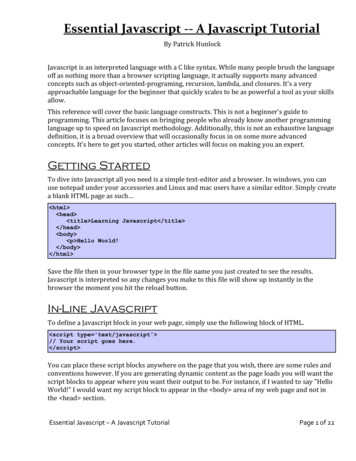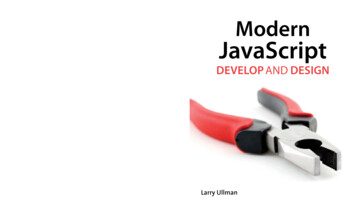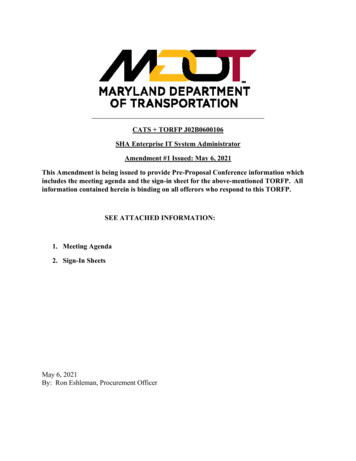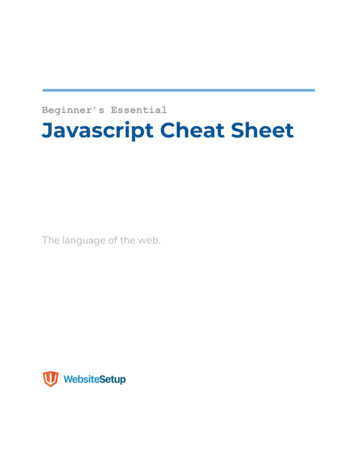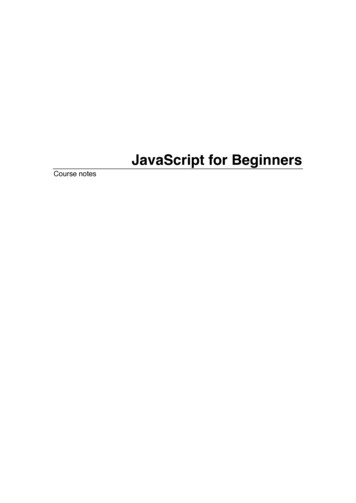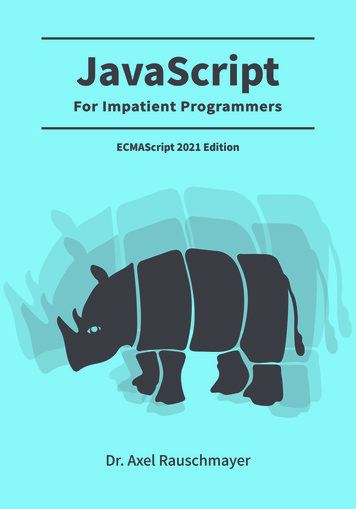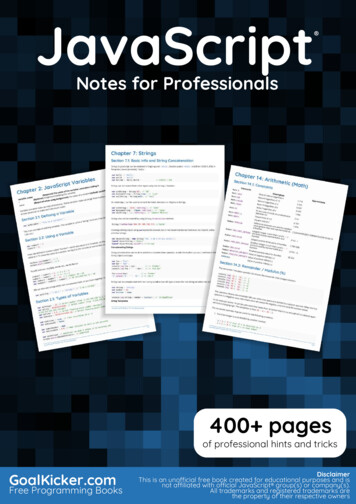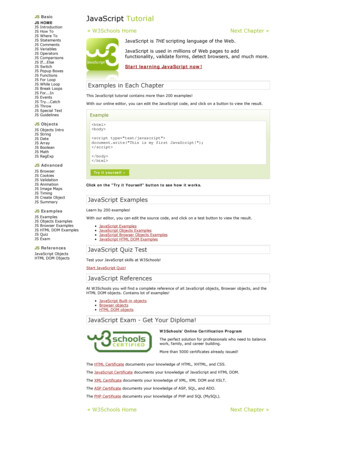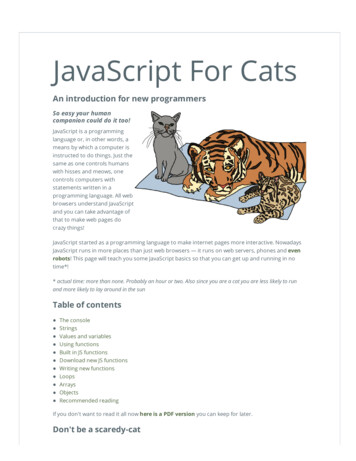
Transcription
JavaScript For CatsAn introduction for new programmersSo easy your humancompanion could do it too!JavaScript is a programminglanguage or, in other words, ameans by which a computer isinstructed to do things. Just thesame as one controls humanswith hisses and meows, onecontrols computers withstatements written in aprogramming language. All webbrowsers understand JavaScriptand you can take advantage ofthat to make web pages docrazy things!JavaScript started as a programming language to make internet pages more interactive. NowadaysJavaScript runs in more places than just web browsers — it runs on web servers, phones and evenrobots! This page will teach you some JavaScript basics so that you can get up and running in notime*!* actual time: more than none. Probably an hour or two. Also since you are a cat you are less likely to runand more likely to lay around in the sunTable of contentsThe consoleStringsValues and variablesUsing functionsBuilt in JS functionsDownload new JS functionsWriting new functionsLoopsArraysObjectsRecommended readingIf you don't want to read it all now here is a PDF version you can keep for later.Don't be a scaredy-cat
You will always land on your feet —even when programming! Unlikepawing over a glass of water on yourlaptop, nothing in these tutorials willdamage your computer in any way,even if you mistype a command or clickthe wrong button. Like cats, computerprogrammers make mistakes all time:misspelling things, forgetting quotes orbrackets, and being forgetful of howbasic functions (and yarn) work.Programmers care more about makingit work eventually rather than trying tomake it work the very first time. Thebest way to learn is by making mistakes!So don't be a scaredy-cat! The absoluteworst thing that will happen is that youmight have to refresh this page in your web browser if you get stuck. Don't worry though, this willhappen very rarely — and we're talkin' 13-toed cat rare.# The basicsThere is JavaScript running on this page right now! Let's play around with it a little. For the sake ofsimplicity I'll assume you are using Google Chrome to read this page (if you aren't it's probablyeasier on both of us if you follow along with Chrome).First, right click anywhere on the screen and hit Inspect Element, then click on the Console tab. Youshould see a thingy that looks like this:This is a console, otherwise known as a "command line" or "terminal". Basically its a way to type onething at a time into a computer and immediately get the computers answer back. They are superuseful as a learning tool (I still use the console nearly every day that I'm coding).The console does some pretty cool stuff. Here I have started to type something and the console ishelping me out by giving me a list of all the possible things I could continue to type! Another thingyou could do is type 1 1 into the console and then hit the Enter key and watch what happens.Using the console is a very important part of learning JavaScript. If you don't know if something
works or what the command is for something, go to the console and figure it out! Here's anexample:# StringsSince I am a cat I want to replace every instance of the worddogsdogon the Internet with. First go into your console and type in a few sentences that contain the worddogthose blastedat least once.In JavaScript a bunch of letters, numbers, words or anything else is known as a String (as in a stringof characters). Strings have to begin AND end with a quotation mark. Single ' or double " is fine,just make sure you use the same at the beginning as you do at the end.See the nasty error message? Don't worry - you didn't break any laws. SyntaxError ILLEGAL is justthe way it sounds when robots tell you that your program has a problem. The first two sentenceshad matching quotation marks at the beginning and end, but when I mixed single and doublequotation marks it freaked out on me.OK, to fix up one of these sentences (by replacing dog with our enhanced version) we have to firstsave the original sentence so that we can call it up later when we do our replacing magic. Notice howthe string gets repeated in red when we type it into the console? This is because we haven't told it tosave the sentence anywhere so it just gives it right back (or it gives us an Error back if we messedsomething up).# Values and variablesValues are the simplest components in JavaScript. 1 is a value, true is a value, "hello" is a value,function() {} is a value, the list goes on! There are a handful of different types of values inJavaScript but we don't need to go over them all right away — you will learn them naturally the moreyou code!To store values we use things called variables. The word 'variable' means 'can change' and is usedbecause variables can store many different types of values and can change their value many times.They are pretty much like mailboxes. We put something in a variable, like our sentence, and thengive the variable an address that we can use to look up the sentence later. In real life mailboxes haveto have PO Box numbers but in JavaScript you usually just use lowercase letters or numbers withoutany spaces.
is shorthand for variable and the means store the thing on the right-hand side in the thing on theleft-hand side. Also as you can see, now that we are storing our sentence in a variable the consolevardoesn't just return our sentence right away, but instead gives usundefinedwhich means there wasnothing to return.If you simply type a variable name into the console it will print out the value stored in that variable. Anote about variables is that by default they go away when you switch to a different page. If I were tohit the Refresh button in Chrome, for example, mydogSentencevariable would get wiped and itwould be like it never existed. But don't worry about this too much for now — you can just hit the upor down arrows on your keyboard while in the console to go through everything you've entered inrecently.# FunctionsNow that we have our sentence stored in a variable let's give that variable to something that willreplace words! We call things that perform actions like this functions because, well, they serve aspecific function (AKA purpose or action) for us. Calling them "actions" sounded weird I guess so theywent with the word "function" instead.JavaScript has a function calledreplacethat does exactly what we want! Functions take in anynumber of values (zero, one or many) and return either nothing ( undefined ) or exactly one value(functions can't return two or more values at a time — only a single value). The replace function isavailable to use on any strings and takes in two values: the characters to take out and the charactersto swap in. It gets confusing to describe these things so here is a visual example:
Notice how the value ofreplacedogSentenceis the same even after we runreplaceon it? This is because(and most JavaScript functions for that matter) takes the variable or value that we give itand returns a new value instead of modifying the thing we passed in. Since we didn't store the newvariable (there is no on the left side of the replace function) it just printed out the return value inour console.# The "standard library"You might be wondering what other functions are available in JavaScript. The answer: A TON. Thereare lots built in, standard libraries that you can learn about at MDN (A site run by Mozilla that haslotsa nifty information about web technologies). For example here is the MDN page on JavaScript'sMath object.# Third-party JavaScriptThere is also a lot of JavaScript code available that is not built in. JavaScript from third parties isusually referred to as a "library" or "plugin". One of my favorites is called Underscore.js. Let's go andgrab it and load it into our page! First go to the Underscore site, http://underscorejs.org/, click onthe download link (I usually use development versions because they are easier to read but both willgive you the same basic functionality), and then copy all the code onto your clipboard (you can useSelect All from the Edit menu to select everything).Then paste it into your console and hit enter. Now your browser has a new variable in it: .Underscore gives you a ton of helpful functions to play with. We'll learn more about how to usethem later.
# Making new functionsYou aren't limited to using other peoples functions — you can also write them yourself. It's prettyeasy! Let's make a function calledmakeMoreExcitingthat adds a bunch of exclamation points to theend of a string.function makeMoreExciting(string) {return string '!!!!'}In my head I read it out loud like this: "there's a function called 'make more exciting' that takes in astring and returns a new copy of that string that has a bunch of exclamation points at the end". Hereis how we would write this in the console manually if we weren't using a function:The expression string '!!!!' returns a new string and our variable calledas before (since we never updated it to anything else with ).stringstays the sameLet's use our function instead of doing it manually. First, paste the function into the console andthen call the function by passing in a string:
You could also call the same function by passing in a variable that points to a string (in the aboveexample we just typed the string straight in there as a value instead of saving it to a variable first):The line makeMoreExciting(sentence) is equivalent to saying sentence '!!!!' . What if we wanted tomodify in-place (aka update) the value of sentence? Simply save the return value of the functionback into our sentence variable:var sentence "time for a nap"sentence makeMoreExciting(sentence)Nowsentencewill have the exclamation marks in it! Note that you only have to usevarare initializing a variable — the first time you ever use it. After that you shouldn't useyou want to re-initialize (reset/clear/empty) the variable.What would happen if we took out thereturnstatement in our function?when youvarunless
Why is sentence empty? Because functions return undefined by default! You can choose to return avalue by return ing something. Functions should take in a value and, if they change the value orcreate a new value that is supposed to be used later, return a value (fun fact: a fancy term for thisstyle is functional programming). Here is another function that doesn't return anything but insteaduses a different method to show us the output:function yellIt(string) {string string.toUpperCase()string makeMoreExciting(string)console.log(string)}This function, yellIt , uses our previous function makeMoreExciting as well as the built-in Stringmethod toUpperCase. Methods are just a name for a function when it belongs to something — inthis case toUpperCase is a function that belongs to String so we can refer to it as either a method ora function. makeMoreExciting on the other hand doesn't belong to anyone so it would be technicallyincorrect to refer to it as a method (confusing, I know).The last line of the function is another built-in that simply takes in any values that you give it andprints them out into the console.
So is there something wrong with the aboveyellItfunction? It depends! Here are the two majortypes of functions:functions that modify or create values and return themfunctions take in values and perform some action that cannot be returnedconsole.logis an example of the second type of function: it prints things out to your console — anaction that you can see with your eyes but that cannot be represented as a JavaScript value. My ownrule of thumb is to try to keep the two types of functions separate from each other, so here's how Iwould rewrite theyellItfunction:function yellIt(string) {string string.toUpperCase()return makeMoreExciting(string)}console.log(yellIt("i fear no human"))This wayyellItbecomes more generic, meaning it only does one or two simple little things anddoesn't know anything about printing itself to a console — that part can always be programmedlater, outside the function definition.# LoopsNow that we have some basic skills under our belt (Author's note: do cats even wear belts?) we can startbeing lazy. What?! Yes, that's right: programming is about being lazy. Larry Wall, inventor of the Perlprogramming language, called laziness the most important virtue of a good programmer. Ifcomputers didn't exist you would have to do all sorts of tedious tasks by hand, but if you learn toprogram you can lay in the sun all day while a computer somewhere runs your programs for you. Itis a glorious lifestyle filled with relaxation!Loops are one of the most important ways to harness the power of a computer. Rememberfrom earlier? Make sure you have it loaded in the page (remember: you can just hitthe up arrow on your keyboard a few times and then hit Enter to load it in again if you need to) andUnderscore.jstry copy/pasting this into your console:function logANumber(someNumber) {console.log(someNumber)}
.times(10, logANumber)This code uses the times method of Underscore which takes in 1 number and 1 function and thenstarts from 0 and for 10 steps counts up by 1, calling the function with the number each step of theway.If we were to manually write out whattimesis doing in the above code it would look like Number(7)logANumber(8)logANumber(9)But cats refuse to do unnecessary manual work like this so we must always ask ourselves, "am I doingthis in the laziest way possible?".So why is this called looping? Think of it like this: If we were to write out a list of 10 numbers (from 0to 9) using a JavaScript Array it would look like this:var zeroThroughTen [0, 1, 2, 3, 4, 5, 6, 7, 8, 9]What times really does is visit each number and repeat a task: in the example above the task was tocall the logANumber function with the current number. Repeating tasks in this way is referred to a
If you don't want to read it all now here is a PDF version you can keep for later. Don't be a scaredy-cat. You will always land on your feet — even when programming! Unlike pawing over a glass of water on your laptop, nothing in these tutorials will damage your computer in any way, even if you mistype a command or click the wrong button. Like cats, computer programmers make mistakes all time .
